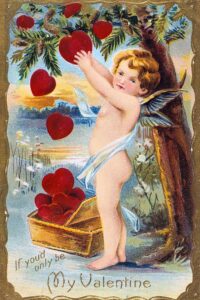The Real History of Valentine’s Day: Cupid and Hearts of Fire

From a raucous Roman festival to Christian martyrs to a medieval celebration of spring, we explore the origins of our most romantic holiday.
Valentine’s Day today is a sweet day of pinks and purples, boxes of chocolate, and bouquets. Schoolchildren craft cute boxes to collect valentines from classmates, while we plan romantic dinners and exchange sentimental gifts with our one and only. But the holiday’s history is a bit more complicated. Here we give you a succinct yet informative Valentine’s Day history, from its origins to its celebration today.
Students of history might often ask if the day has pagan origins or spiritual ones and what the meaning of the day was originally intended to be. You might also wonder how it became a romantic holiday and eventually a commercial one. To answer those questions and more, we’re sharing some basic Valentine’s Day facts, plus some legends, involving saints, a Roman holiday called Lupercalia, and the poet Geoffrey Chaucer (who knew?). No matter how you celebrate the holiday, you’re sure to be interested in its storied history.
Now let’s get started on it from the beginning…
Where does the name Valentine come from?
The holiday is aptly named after Saint Valentine, but who exactly was he? Valentine is likely based on a combination of two Valentines who were executed on February 14 in different years by Roman Emperor Claudius II in the 3rd century A.C.E., according to NPR. The Catholic Church maybe have established St. Valentine’s Day to honor these two martyrs. Legend says that one of these men, Saint Valentine of Terni, had officiated weddings for Roman soldiers in secret, going against the emperor’s wishes, making him seen to some as a proponent of love.
Another story involves the practice of writing love letters to your valentine. It’s said that St. Valentine wrote the first “valentine” greeting to a young girl he tutored and fell in love with while he was imprisoned for the crimes outlined above. According to The History Channel, before his death, he wrote her a letter signed “From your Valentine,” which remains a commonly used phrase to this day. But these romantic anecdotes are only legends. So little historical information is known about the martyrs named St. Valentine that in 1969 the Roman Catholic Church removed the feast day from its calendar, though St. Valentine is still recognized as a saint.
Does Valentine’s Day have pagan origins?
There was a mid-February fertility festival in ancient Roman called Lupercalia, which some believe was a forerunner to Valentine’s Day (and the rest of this paragraph is not PG). Dedicated to the Roman god of agriculture, Faunas, and Roman founders Romulus and Remus, this feast of debauchery involved a ritual where an order of Roman priests ran naked through the streets, “gently slapping” women with the blood-soaked hides of sacrificed animals (yes, really), which they believed promoted fertility. Later, notes Britannica.com, the women would be paired off with men “by lottery.” In the late 5th century, Pope Gelasius I outlawed Lupercalia. Some contend that he designated the celebration of St. Valentine’s Day on February 14 to replace the pagan holiday.
When did Valentine’s Day become a romantic holiday?
If you’re thinking that none of this sounds very lovey-dovey, that’s because Valentine’s Day did not begin to resemble the romantic holiday we know today until the Middle Ages—and we might have the poet Geoffrey Chaucer to thank. The late scholar Jack B. Oruch, a University of Kansas English professor, determined that Chaucer was the first to link love with St. Valentine in his 14th-century works “The Parliament of Fowls” and “The Complaint of Mars,” notes the Times. Therefore, Oruch claimed, Chaucer invented Valentine’s Day as we know it today.
At the time of Chaucer’s writing, February 14 also happened to be considered the first day of spring in Britain, because it was the beginning of birds’ mating season—perfectly appropriate for a celebration of affection. In fact, Chaucer’s “The Parliament of Fowls” is all about birds (albeit anthropomorphized ones) gathering to choose their mates: “For this was on Saint Valentine’s day, / When every fowl comes there his mate to take,” reads one of the verses.
Why didn’t Chaucer just write “For this was on February 14…”? Poetry aside, it would not have been the convention of the times. In a blog post for The Folklore Society, folklorist Jacqueline Simpson explains it this way: “In the Catholic Church every day in the year celebrates at least one saint, and for a public who had no printed calendars it was easier to remember dates by names than by figures.”
Why do we celebrate Valentine’s Day?
Whether or not Chaucer can be fully credited, it is true that he and fellow writer Shakespeare popularized the amorous associations surrounding the day. Soon, people began penning and exchanging love letters to celebrate Valentine’s Day.
The mid-19th century marked the beginning of many of the commercialized Valentine’s Day traditions we know today. Victorian men wooed women with flowers, Richard Cadbury created the first heart-shaped box of chocolates, and the New England Confectionery Company, or Necco, began stamping out an early version of Conversation Hearts. Also around this time, the “Mother of the American Valentine” Esther Howland, only in her early 20s, popularized store-bought English-style valentines in America thanks to her innovative assembly line process that made the elaborate cards affordable. (Google some of Howland’s creations—they will inspire you to DIY your own Valentine’s Day cards!) By the early 1910s, an American company that would one day become Hallmark began distributing its more official “Valentine’s Day cards.” The rest, of course, is history.
What part does Cupid play on Valentine’s Day?
It’s not all about St. Valentine! Cupid—that winged baby boy often seen on Valentine’s Day cards and paraphernalia—is another symbol of this love-filled holiday, and it’s easy to understand why. In Roman mythology, Cupid was the son of Venus, goddess of love and beauty. He was known for shooting arrows at both gods and humans, causing them to fall instantly in love with one another. While it’s unclear exactly when Cupid was brought into the Valentine’s Day story, it’s certainly clear why. ~by Taysha Murtaugh

Although above is an excellent research by the author, we would like making clear that from an astrological point of view, Cupid, the son of Venus, represents children. It represents Family. It represents creation continuing.
Planet or star Venus, and for those that are not aware of, and within the astrological round, Venus rules Libra, as well as Taurus, etc. Both of these signs are connected to family.+ and Friendships whether intimate relationships; marriages, and or relationships as that we find within the work environment, businesses, etc., etc. These signs are also connected to finances of any kind, especially in the sign of Taurus. And balance within the sign of Libra. Regardless, what we are getting at, is that Venus represents humanity in many ways- especially the human female. In fact, it is Venus that have the sacred logo of a human Vagina.
And we all know that it is through the human vagina that creation starts when referring to the human species. The human vagina is the portal where it can take a man or a woman to heaven or to hell. It is the portal that ultimately would lead a man or woman be a powerful god or goddess.
It is also the portal where a precious jewelry as a human baby comes from. It is the portal where the children of our Creator comes from to experience physical reality.
And we all know how precious children are. We all know that children are a piece of our heart. We all know that children are the Creator’s precious jewelry. We all know that it took the union of a man and a woman in full communion; in full commitment to create; to manifest a child. A baby. A precious gift from our Creator.
Who does not feel attractive to the essence of a baby. Who does not feel the magical connection when we are in front of a newborn!
How beautiful thou art! How magnificent is our Almighty Creator God! And how magnificent and divine are our precious children. Our children that are the future generation. That are our future!
And so when Cupid, the son of Venus send an arrow to the people and or to the gods, and or to anyone, his intentions are for us all to stop and give LOVE an opportunity. As without love, there it would not be not even an opportunity for anything. Love is that force that would make us balance thing. That would make us reflect and do the right thing. That would make us honor the magnificence of our own Creator as are our children. As it is the family. As it is friendship. As it is balance for all the existence be in harmony. For all the existence be prosperous. Be courageous. Be bravery. Be empower. Be with greatness.
Protection and greatness be for all our children! Protection and greatness be for all our men. Protection and greatness be for all our women. All across the world.
Heart.
Related:
http://www.freeport1953.com/play-to-the-beat-of-your-own-drum-new-moon/
For more, visit our Home page, and Facebook on top left.
http://www.freeport1953.com/the-real-history-of-valentines-day-cupid-and-hearts-of-fire/ = this posting
~LFabre

